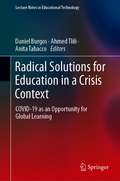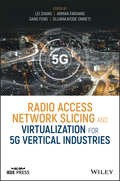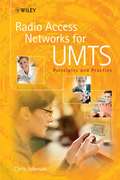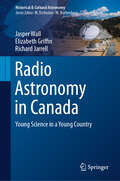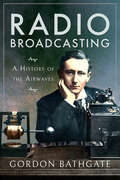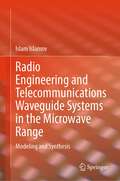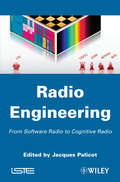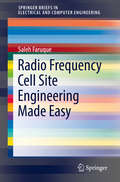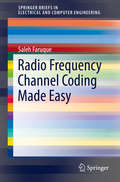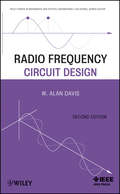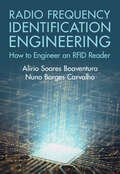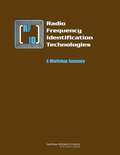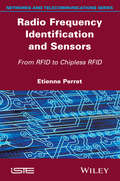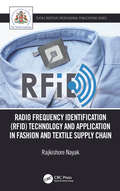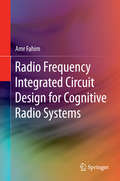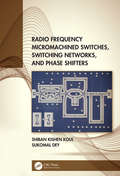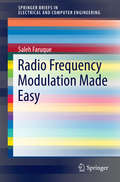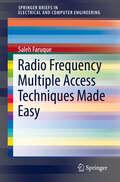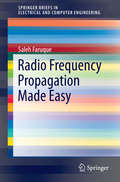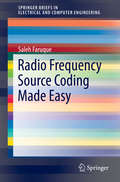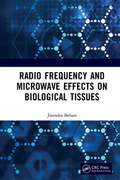- Table View
- List View
Radical Solutions for Education in a Crisis Context: COVID-19 as an Opportunity for Global Learning (Lecture Notes in Educational Technology)
by Anita Tabacco Daniel Burgos Ahmed TliliThis book presents how to keep working on education in contexts of crisis, such as emergencies, zones of conflict, wars and health pandemics such as COVID-19. Specifically, this work shows a number of strategies to support global learning and teaching in online settings. Particularly, it first presents how to facilitate knowledge sharing and raising awareness about a specific crisis, to increase people’s safety, including educators and learners. The book then discusses various techniques, mechanisms and services that could be implemented to provide effective learning support for learners, especially in learning environments that they do not daily use, such as physical classrooms. Further, the work presents how to teach and support online educators, no matter if they are school teachers, university lecturers, youth social workers, vocational training facilitators or of any other kind. Finally, it describes worldwide case studies that have applied practical steps to keep education running during a crisis.This book provides readers with insights and guidelines on how to maintain learning undisrupted during contexts of crisis. It also provides basic and practical recommendations to the various stakeholders in educational contexts (students, content providers, technology services, policy makers, school teachers, university lecturers, academic managers, and others) about flexible, personalised and effective education in the context of crisis.
Radical Solutions in Palestinian Higher Education: Research from An-Najah National University (Lecture Notes in Educational Technology)
by Daniel Burgos Saida AffounehThis book brings together education research and practice carried out by An-Najah National University, a lead Higher Institution in Palestine that managed to move from a face-to-face setting to a fully online learning and teaching environment during the initial COVID-19 outbreak, within a month, seamlessly, which makes a success cases study of virtualization. This book concentrates on approaches to ensure the continuous improvement and quality of higher education provision across the country, with particular focus on: a) learning and teaching methodologies in online settings; b) use of open education as a key resource; and c) development of academic capability building, along with academic and knowledge exchange with other higher education partners. Innovative ideas, best practices, and comparative case studies are presented, discussed, and compared with international ones to make specific recommendations for a successful and sustainable implementation.
Radical by Nature: The Revolutionary Life of Alfred Russel Wallace
by James T. CostaA major biography of the brilliant naturalist, traveler, humanitarian, and codiscoverer of natural selectionAlfred Russel Wallace (1823–1913) was perhaps the most famed naturalist of the Victorian age. His expeditions to remote Amazonia and southeast Asia were the stuff of legend. A collector of thousands of species new to science, he shared in the discovery of natural selection and founded the discipline of evolutionary biogeography.Radical by Nature tells the story of Wallace&’s epic life and achievements, from his stellar rise from humble origins to his complicated friendship with Charles Darwin and other leading scientific lights of Britain to his devotion to social causes and movements that threatened to alienate him from scientific society.James Costa draws on letters, notebooks, and journals to provide a multifaceted account of a revolutionary life in science as well as Wallace&’s family life. He shows how the self-taught Wallace doggedly pursued bold, even radical ideas that caused a seismic shift in the natural sciences, and how he also courted controversy with nonscientific pursuits such as spiritualism and socialism. Costa describes Wallace&’s courageous social advocacy of women&’s rights, labor reform, and other important issues. He also sheds light on Wallace&’s complex relationship with Darwin, describing how Wallace graciously applauded his friend and rival, becoming one of his most ardent defenders.Weaving a revelatory narrative with the latest scholarship, Radical by Nature paints a mesmerizing portrait of a multifaceted thinker driven by a singular passion for science, a commitment to social justice, and a lifelong sense of wonder.
Radio Resource Management in Wireless Networks
by Ekram Hossain Long Bao Le Mehdi RastiDo you need to design efficient wireless communications systems? This unique text provides detailed coverage of radio resource allocation problems in wireless networks and the techniques that can be used to solve them. Covering basic principles and mathematical algorithms, and with a particular focus on power control and channel allocation, you will learn how to model, analyze, and optimize the allocation of resources in both physical and data link layers, and for a range of different network types. Both established and emerging networks are considered, including CDMA and OFDMA wireless networks, relay-based wireless networks, and cognitive radio networks. Numerous exercises help you put knowledge into practice, and provide the tools needed to address some of the current research problems in the field. This is an essential reference whether you are a graduate student, researcher or industry professional working in the field of wireless communication networks.
Radio Access Network Slicing and Virtualization for 5G Vertical Industries (Wiley - IEEE)
by Lei ZhangLearn how radio access network (RAN) slicing allows 5G networks to adapt to a wide range of environments in this masterful resource Radio Access Network Slicing and Virtualization for 5G Vertical Industries provides readers with a comprehensive and authoritative examination of crucial topics in the field of radio access network (RAN) slicing. Learn from renowned experts as they detail how this technology supports and applies to various industrial sectors, including manufacturing, entertainment, public safety, public transport, healthcare, financial services, automotive, and energy utilities. Radio Access Network Slicing and Virtualization for 5G Vertical Industries explains how future wireless communication systems must be built to handle high degrees of heterogeneity, including different types of applications, device classes, physical environments, mobility levels, and carrier frequencies. The authors describe how RAN slicing can be utilized to adapt 5G technologies to such wide-ranging circumstances. The book covers a wide range of topics necessary to understand RAN slicing, including: Physical waveforms design Multiple service signals coexistence RAN slicing and virtualization Applications to 5G vertical industries in a variety of environments This book is perfect for telecom engineers and industry actors who wish to identify realistic and cost-effective concepts to support specific 5G verticals. It also belongs on the bookshelves of researchers, professors, doctoral, and postgraduate students who want to identify open issues and conduct further research.
Radio Access Networks for UMTS
by Chris JohnsonThis book provides a comprehensive description of Radio Access Networks for UMTS . The main content is based upon the release 6 version of the 3GPP specifications. Changes since the release 99 version are described while some of the new features from the release 7 version are introduced.Starting from the high-level network architecture, the first sections describe the flow of data between the network and end-user. This includes a dedicated chapter describing the Iub transport network. Detailed descriptions of both HSDPA and HSUPA reflect the increasing importance of efficient high data rate connections. Signalling procedures are described for speech, video and PS data connection establishment, SMS data transfer, soft handover and inter-system handover. The more practical subjects of link budgets and radio network planning are also addressed.More than 180 example log files reinforce the reader's understandingSummary bullet points allow rapid access to the most important informationFocus upon how data is transferred between the network and end-userDedicated chapters provide detailed descriptions of both HSDPA and HSUPAStep-by-step analysis of common signalling proceduresKey radio network planning subjects addressedRadio Access Networks for UMTS is ideal for mobile telecommunications engineers working for equipment vendors, operators and regulators. It will also appeal to system designers, technical managers and students.
Radio Astronomy in Canada: Young Science in a Young Country (Historical & Cultural Astronomy)
by Elizabeth Griffin Richard Jarrell Jasper WallHere is the tale of Canada’s intriguing development of the science of Radio Astronomy. In 1946 the lone figure of Arthur Covington started monitoring the radio emission of the Sun, a programme that continues to this day. By the 1960s Canada had progressed to constructing two radio observatories at either ends of the country (the DRAO and the ARO), and universities were coming onboard. The story continues through the dire times for these and follows their fortunes and fates right up to the present, with Canada now playing key roles in billion-dollar international telescope projects. It concludes with the construction and operation of Canada’s own transformational telescope, CHIME. Anecdotes and images throughout the book liven the story.The authors—two practising astronomers—have painstakingly put together this fascinating story, drawing on first-hand experiences, valuable contributions from many colleagues, and the research of science historian, Richard Jarrell (1942-2013).This book fills a gap in the substantial literature on the history of radio astronomy. Carefully-researched by three experts and based on input by further experts in the field, it documents the extensive scientific and (especially) technical innovations of Canadian scientists and engineers. This includes the important Canadian absolute flux-density calibrations, the critical Canadian contribution to low-frequency radio astronomy and VLBI, and the long-running solar monitoring programme. Frank discussions about the excellent 46-m ARO telescope and its fate lead into considerations of Canada’s contributions to recent international projects – the JCMT, ALMA and the upcoming SKA. The book concludes with a description of CHIME, Canada’s own new-generation radio installation.Ken Kellermann, Senior Scientist Emeritus, National Radio Astronomy Observatory, Charlottesville, USA
Radio Broadcasting: A History of the Airwaves
by Gordon BathgateAn in-depth look at a century of radio history—and its continuing relevance in a radically changed world.A century after Marconi’s experimental transmissions, this book examines the history of radio and traces its development from theories advanced by James Clerk Maxwell and Heinrich Hertz to the first practical demonstrations by Guglielmo Marconi. It looks back to the pioneering broadcasts of the BBC, examines the development of broadcast networks in North America and around the world, and spotlights radio’s role in the Second World War.The book also features the radio programs and radio personalities that made a considerable impact on listeners during the “Golden Era.” It examines how radio, faced by competition from television, adapted and survived. Indeed, radio has continued to thrive despite increased competition from mobile phones, computers, and other technological developments. Radio Broadcasting looks ahead and speculates on how radio will fare in a multi-platform future.
Radio Engineering and Telecommunications Waveguide Systems in the Microwave Range: Modeling and Synthesis
by Islam IslamovThe book systematizes numerical methods for modelling and synthesizing radio engineering and telecommunication systems in the microwave range of rectangular and circular waveguides. The author gives the theoretical foundations for the analysis and optimal synthesis of these systems and presents the results of new research. The book uses the HFSS complex to analyse, optimize, and synthesize microwave systems operating on E-type and H-type waves while providing the outcomes. As a result of analysis and synthesis, various microwave devices with improved technical and operational parameters have been developed, and on their basis a new system of waveguide paths is proposed that connects the transmitter and antenna in TV towers. The book is intended for engineers and scientists involved in the design of radio engineering and telecommunication systems.
Radio Engineering: From Software Radio to Cognitive Radio (Lecture Notes Of The Institute For Computer Sciences, Social Informatics And Telecommunications Engineering Ser. #172)
by Jacques Palicot Pierre‐Noël FavennecSoftware radio ideally provides the opportunity to communicate with any radio communication standard by modifying only the software, without any modification to hardware components. However, taking into account the static behavior of current communications protocols, the spectrum efficiency optimization, and flexibility, the radio domain has become an important factor. From this thinking appeared the cognitive radio paradigm. This evolution is today inescapable in the modern radio communication world. It provides an autonomous behavior to the equipment and therefore the adaptation of communication parameters to better match their needs. This collective work provides engineers, researchers and radio designers with the necessary information from mathematical analysis and hardware architectures to design methodology and tools, running platforms and standardization in order to understand this new cognitive radio domain.
Radio Frequency Cell Site Engineering Made Easy (SpringerBriefs in Electrical and Computer Engineering)
by Saleh FaruqueThis book introduces Radio Frequency Cell Site Engineering to a broad audience. The author blends theory and practice to bring readers up-to-date in key concepts, underlying principles and practical applications of wireless communications. The presentation is designed to be easily accessible, minimizing mathematics and maximizing visuals.
Radio Frequency Channel Coding Made Easy
by Saleh FaruqueThis book introduces Radio Frequency Channel Coding to a broad audience. The author blends theory and practice to bring readers up-to-date in key concepts, underlying principles and practical applications of wireless communications. The presentation is designed to be easily accessible, minimizing mathematics and maximizing visuals.
Radio Frequency Circuit Design
by W. Alan DavisThis book focuses on components such as filters, transformers, amplifiers, mixers, and oscillators. Even the phase lock loop chapter (the last in the book) is oriented toward practical circuit design, in contrast to the more systems orientation of most communication texts.
Radio Frequency Identification Engineering: How to Engineer an RFID Reader
by Alírio Soares Boaventura Nuno Borges CarvalhoRadio Frequency Identification Engineering Radio frequency identification (RFID) has become an undeniable aspect of modern living, being used from logistics, access control, and electronic payment systems to artificial intelligence, and as a key building block of the internet of things. Presenting a unique coverage of RFID reader design and engineering, this is a valuable resource for engineers and researchers, aiding in their mission of fulfilling current and future demands in the RFID space. Providing a cohesive compilation of technical resources for full-stack engineering of RFID readers, the book includes step-by-step techniques, algorithms, and source code that can be incorporated in custom designs. Readers are invited to explore the design of RFID interrogators based on software-defined radio for flexible, upgradeable solutions as well as low-complexity techniques for engineering low-cost RFID readers. Additionally, the authors provide insight into related topics such as waveform design optimization for improved reading range and novel quadrature backscatter modulation techniques.
Radio Frequency Identification Technologies: A Workshop Summary
by Committee on Radio Frequency Identification TechnologiesRadio Frequency Identification (RFID) technology is gaining rapid acceptance as a means to track a wide array of manufactured objects. Currently, RFID technologies have shown promise in transportation (e.g., smart fare cards) and commerce (e.g., inventory control) for a variety of uses and are likely to find many new applications in both military and civilian areas if and when current technical issues are resolved. There are a number of policy concerns (e.g., privacy), however, that will become more crucial as the technology spreads. This report presents a summary of a workshop, held by the NRC at the request of the Defense Advanced Research Projects Agency, to explore many of the key technical and policy issues. Several important themes that are likely to govern expansion of RFID technology emerged from the workshop and are discussed.
Radio Frequency Identification and Sensors
by Etienne PerretThis book deals with the field of identification and sensors, more precisely the possibility of collecting information remotely with RF waves (RFID). The book introduces the technology of chipless RFID starting from classical RFID and barcode, and explores the field of identification and sensors without wire, without batteries, without chip, and with tags that can even be printed on paper.A technique for automatic design of UHF RFID tags is presented , aiming at making the tags as insensitive as possible to the environment (with the ability to increase the reading range reliability), or, conversely, making them sensitive in order to produce sensors, meanwhile keeping their unique ID. The RFID advantages are discussed, along with its numerous features, and comparisons with the barcode technology are presented. After that, the new chipless RFID technology is introduced on the basis of the previous conclusions. Original technological approaches are introduced and discussed in order to demonstrate the practical and economic potential of the chipless technology.
Radio Frequency Identification: Technology and Application in Garment Manufacturing and Supply Chain (Textile Institute Professional Publications)
by Rajkishore NayakRadio Frequency Identification (RFID) Technology and Application in Fashion and Textile Supply Chain highlights the technology of Radio Frequency Identification (RFID) and its applications in fashion and textile manufacturing and supply chain management. It discusses the brief history, technology, and working of RFID including the types of RFID systems. It compares differences, advantages, and disadvantages of RFID and barcode technologies. It also covers application of RFID technology in textile and fashion manufacturing, supply chain, and retail, and RFID-based process control in textile and fashion manufacturing. It covers various applications of RFID starting from fibre manufacturing through yarn and fabric manufacturing; fabric chemical processing; garment manufacturing and quality control; and retail management. It offers case studies of RFID adoption by famous fashion brands detailing the competitive advantages and discusses various challenges faced and future directions of RFID technology.
Radio Frequency Integrated Circuit Design for Cognitive Radio Systems
by Amr FahimThis book fills an information gap on cognitive radios, since the discussion focuses on the implementation issues that are unique to cognitive radios and how to solve them at both the architecture and circuit levels. This is the first book to describe in detail cognitive radio systems, as well as the circuit implementation and architectures required to implement such systems. Throughout the book, requirements and constraints imposed by cognitive radio systems are emphasized when discussing the circuit implementation details. This is a valuable reference for anybody with background in analog and radio frequency (RF) integrated circuit design, needing to learn more about integrated circuits requirements and implementation for cognitive radio systems.
Radio Frequency Integrated Circuits and Systems
by Hooman DarabiFocusing on the core topics of RF IC and system design, this textbook provides the in-depth coverage and detailed mathematical analyses needed to gain a thorough understanding of the subject. Throughout, theory is linked to practice with real-world application examples; practical design guidance is also offered, covering the pros and cons of various topologies, and preparing students for future work in industry. Written for graduate courses on RFICs, this uniquely intuitive and practical book will also be of value to practising RF IC and system designers. Key topics covered include RF components, signals and systems; two-ports; noise; distortion; low-noise amplifiers; mixers; oscillators; power amplifiers; and transceiver architectures. Lecture slides and a solutions manual for instructors are provided online to complete the course package.
Radio Frequency Micromachined Switches, Switching Networks, and Phase Shifters
by Shiban Kishen Koul Sukomal DeyRadio Frequency Micromachined Switches, Switching Networks, and Phase Shifters discusses radio frequency microelectromechanical systems (RF MEMS)-based control components and will be useful for researchers and R&D engineers. It offers an in-depth study, performance analysis, and extensive characterization on micromachined switches and phase shifters. The reader will learn about basic design methodology and techniques to carry out extensive measurements on MEMS switches and phase shifters which include electrical, mechanical, power handling, linearity, temperature stability, reliability, and radio frequency performance. Practical examples included in the book will help readers to build high performance systems/subsystems using micromachined circuits. <P><P> Key Features <li> Provides simple design methodology of MEMS switches and switching networks including SPST to SP16T switches <li> Gives an in-depth performance study of micromachined phase shifters. Detailed study on reliability and power handling capability of RF MEMS switches and phase shifters presented <li> Proposes reconfigurable micromachined phase shifters <li> Verifies a variety of MEMS switches and phase shifters experimentally
Radio Frequency Modulation Made Easy
by Saleh FaruqueThis book introduces Radio Frequency Modulation to a broad audience. The author blends theory and practice to bring readers up-to-date in key concepts, underlying principles and practical applications of wireless communications. The presentation is designed to be easily accessible, minimizing mathematics and maximizing visuals.
Radio Frequency Multiple Access Techniques Made Easy (SpringerBriefs in Electrical and Computer Engineering)
by Saleh FaruqueThis book provides a comprehensive overview of multiple access techniques used in the cellular industry. The usage of multiple access techniques in telecommunications enables many users to share the same spectrum in the frequency domain, time domain, code domain or phase domain. Licenses are given, by the FCC, to operate wireless communication systems over given bands of frequencies, with the smaller bands, (channels), reused to provide services to other users. Thus, bandwidth efficiency is vital, as the speed and size of digital data networks continue to expand. This brief also uses numerous illustrations to bring students up-to-date in the practical applications of multiple access techniques, which can then be put to work in the industry. Primarily, electrical engineering students who study telecommunications, as well as engineers and designers working in wireless communications, would find this book useful.
Radio Frequency Propagation Made Easy
by Saleh FaruqueThis book introduces Radio Frequency Propagation to a broad audience. The author blends theory and practice to bring readers up-to-date in key concepts, underlying principles and practical applications of wireless communications. The presentation is designed to be easily accessible, minimizing mathematics and maximizing visuals.
Radio Frequency Source Coding Made Easy
by Saleh FaruqueThis book introduces Radio Frequency Source Coding to a broad audience. The author blends theory and practice to bring readers up-to-date in key concepts, underlying principles and practical applications of wireless communications. The presentation is designed to be easily accessible, minimizing mathematics and maximizing visuals.
Radio Frequency and Microwave Effects on Biological Tissues
by Jitendra BehariFocussing on engineering aspects of RF/Microwave interaction with biological tissues This book discusses the advancement in bio-electromagnetics pertaining to this important issue of electromagentic field-bio interaction vis-a-vis the emission of electromagnetic radiations from mobile phones and their biological fallout. Divided into six chapters, it discusses basic issues in Electromagnetic Field-Biointeraction, dosimetery, instrumentation, and methods of measurement of specific absorption rate, criteria and magnitude of safe exposure and measurements of field in an open (unobstructed) environment.
